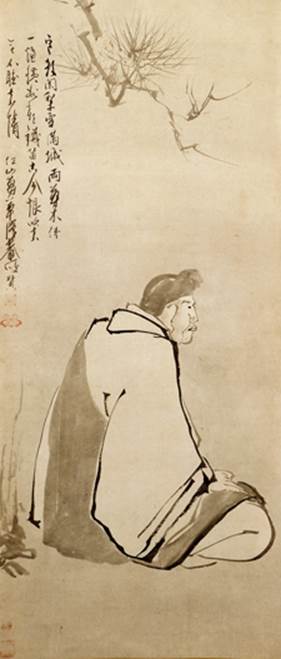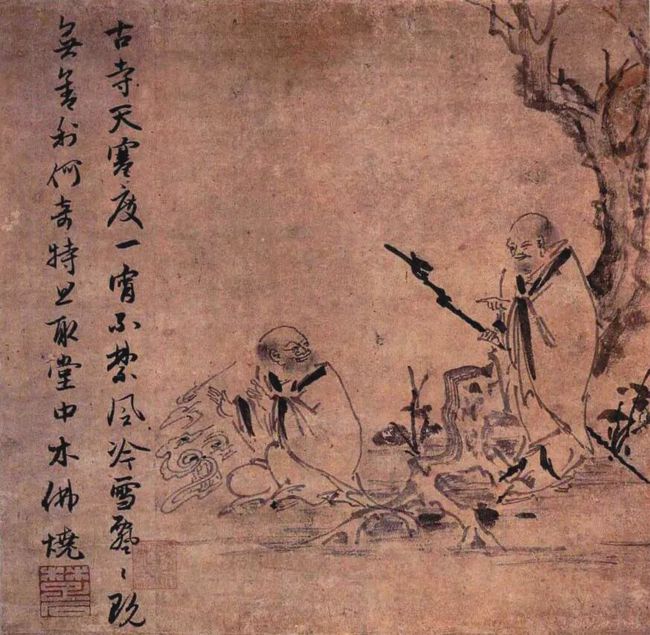Bodhidharma
Baizhang Huaihai
Caoshan Benji
Dahui Zonggao
Daman Hongren
Danxia Tianran
Dayi Daoxin
Dazhao Puji
Dazhu Huihai
Dazu Huike
Deshan Xuanjian
Dongshan Liangjie
Dōgen
Eisai
Guifeng Zongmi
Guishan Lingyou
Guizong Zhichang
Heze Shenhui
Hongzhi Zhengjue
Huangbo Xiyun
Huanglong Huinan
Huineng
Jinshan tanying
Linji Yixuan
Longtan Chongxin
Luohan Guichen
Mazu Daoyi
Nanquan Puyuan
Nanta Guangyong
Nanyang Huizhong
Nanyue Huairang
Niutou Farong
Qingliang Wenyi
Qingyuan Xingsi
Sengcan
Shishuang Chuyuan
Shitou Xiqian
Tianhuang Daowu
Xiangyan Zhixian
Xitang Zhizang
Xuansha Shibei
Xuedou Chongxian
Xuefeng Yicun
Yangqi Fanghui
Yangshan Huiji
Yantou Quanhuo
Yaoshan Weiyan
Yongjia Xuanjue
Yongming Yanshou
Yunmen Wenyan
Yunyan Tansheng
Yuquan Shenxiu
Zhaozhou Congshen
Index
Danxia Tianran

born
739
died
824
religion
Chan
POSTH name
Chan Master Zhitong
teacher
Ma Zu Daoyi, Shitou Xiqian
students
Monk Bentong, Danxia Yi'an
Contents
Biography
Koan
Biography
Danxia Tianran (739-824), the diciple of Master Shitou Xiqian, a famous Chan master in the Tang Dynasty.
At first he studied Confucianism, intending to go to Ch'ang-an to take part in the examinations for official posts. Then unexpectedly while he was staying over at a travellers' lodge, he dreamed that a white light filled the room. A diviner said, “This is an auspicious omen of understanding emptiness.” There happened to be a Ch'an traveller there who asked him, “Good man, where are you going?” He said, “To be chosen to be an official.” The Ch'an traveller said, “How can choosing an official career compare to choosing Buddhahood?” Tan Hsia asked, “What place shold I go to to choose Buddhahood?” The Ch'an traveller said, “At the present time Grand Master Ma has appeared in the world in Kiangsi. This is the place to choose Buddhahood---you should go there, good man.”
After this Tan Hsia went directly to Kiangsi. The moment he saw Grand Master Ma he lifted up the edge of his turban (to look at Ma). Master Ma observed him and said, “I am not your Teacher---go to Shih T'ou's place in Nan Yueh.” Tan Hsia hastened to Nan Yueh where he submitted to Shih T'ou with the same idea as before (at Ma Tsu's place). Shih T'ou told him to go to the stable, and Tan Hsia bowed in thanks. He entered the workmen's hall and worked along with the congregation for three years.
One day Shih T'ou announced to the assembly, “Tomorrow we're going to clear away the weeds in front of the Buddha's shrine.” The next day everyone equipped himself with a hoe to cut down the weeds. Tan Hsia alone took a bowl, filled it with water, and washed his head; then he knelt in front of Master Shih T'ou. Shih T'ou saw this and laughed at him, then shaved his head for him. As Shih T'ou began to explain the precepts for him, Tan Hsia covered his ears and went out.
Then Tan Hsia headed for Kiangsi to call again on Ma Tsu. Before meeting with Ma Tsu to pay his respects, he went into the monks' hall and sat astride teh neck of the holy statue (of Manjusri). At the time everybody became very perturbed and hurried to report this to Ma Tsu. Tsu personally went to the hall to have a look at him and said, “My son is so natural.” Hsia immediately got down and bowed saying, “Thank you, Master, fior giving me a Dharma name.” Because of this he was called T'ien Jan (which means natural). This man of old Tan Hsia was naturally sharply outstanding like this. As it is said, “Choosing officialdom isn't as good as choosing Buddhahood.” His sayings are recorded in the Records of the Transmission of the Lamp.
Koan

Yuan Dynasty, Yintuoluo, "Danxia Tianran burning Buddhist statues"
Dhyana Master Danxia's burning of a Buddha image to get warmth won the admiration of people in later generations. Such people think that to do away with worthies and sages, fathers and mothers, teachers and superiors, as well as all rules is to follow the way of spontaneity, to accord with Nature. Such unmitigated arrogance is truly pitiful.
When Chan Master Danxia knelt and bowed, it was to the Buddha, the self nature. When he burned the image, what he burned was wood, using the nature of fire. In saying that the mind has no discriminations, actually, there are distinctions made; it's just that mundane principles and the principles contained in the Teaching become perfectly fused when one's wisdom opens. Even if he burned all the Buddha images in all the temples and monasteries, he still could not change the fact that Shakyamuni Buddha was his Guiding Master.
By the same principle, if I attempt to destroy the faith which the Chan school proudly places in this story, then that would merely be for my own personal satisfaction. The Chan school is still the Chan school; a Buddha is still a Buddha; and I am still a common person. What if an image of a common person were be burned? At most, the person's family members would fight with you. But the story of Chan Master Danxia burning the wooden Buddha has been discussed for several hundred years. If there were nothing in it, why would people bother to keep talking about it? Only brilliant events warrant such a reaction; and even if one might wish to erase it from history, it cannot be done.
The magnificence of the Buddha is also shown in this: Even after he entered Nirvana, people could still get warmth from a wooden likeness of him.
Contact us
Disclaimer
Comments
© Copyright Jumpypixels.com